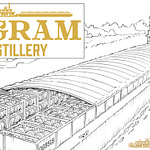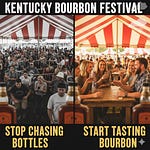There’s something deeply uncomfortable about blind tastings if you’ve spent years developing preferences in whiskey. You’ve learned to recognize distillery profiles, you’ve got favorite brands, you’ve built a mental map of what you like and why. Then someone puts three glasses in front of you with zero information and asks you to put your palate where your mouth is.
That’s exactly what happened when I decided to host a virtual blind tasting for a group of friends I’ve been drinking whiskey with for years. We’re geographically scattered across the country—these guys have become legitimate friends through shared trips, group chats, and an ongoing conversation about whiskey, fatherhood, work, life, all of it. But we don’t get together in person as often as we’d like.
So when someone suggested we do virtual blind tastings as a way to keep the tradition alive, I volunteered to go first. I sent samples to Patrick, Don, Bill, and David. The rules were simple: three bourbons, all eight years old, all hovering around 100-101 proof, all readily available. Claude (yes, an AI) randomized the order. Nobody knew what they were drinking.
Pour 1
The first pour sparked immediate debate. “Smells musty,” Bill said, though we quickly determined his glass was just frosted. David was confident within seconds: “I know which distillery this is. I’d put a bet on it.” He called Buffalo Trace off the nose, doubled down after tasting it, and was dead wrong.
The whiskey in question was Wilderness Trail’s 8-year bottled-in-bond release. Don ultimately nailed it—guessing not just the distillery but the age and proof point. The rest of us were scattered across the map: Barton, Buffalo Trace, even a 1792 guess got thrown around.
Here’s what makes that revealing: Wilderness Trail has a pretty distinctive profile if you’ve had their picks. But when you strip away the context—when you can’t anchor to the label or recall that store pick you loved—suddenly that distinctiveness becomes harder to pin down. Bill noted how the nose kept evolving in the glass: “After I went back, it was chocolatey and then it went back to cherry notes—almost like chocolate-covered maraschino cherries.”
That kind of complexity gets lost when you’re too busy trying to reverse-engineer what distillery made something instead of just experiencing what’s in the glass.
Pour 2
The second whiskey—New Riff’s 8-year—sparked an entirely different kind of debate. Multiple people immediately wondered if it was MGP. Bill wasn’t a fan, noting a “astringent” or “scratchy” quality on the backend that took him out of it. This is where brand perceptions get interesting.
New Riff has worked hard to establish their own identity separate from sourced distillate. They’re transparent about their process, they’re making their own juice, and they’ve built a following around their Kentucky grain-forward style. But when people taste blind and don’t love something, MGP becomes the easy explanation—a catch-all for “this doesn’t fit my preferred profile.”
The reveal was telling. Bill admitted afterward: “Unfortunately I’m not terribly surprised that I wasn’t the biggest fan of New Riff. When I’m looking to grab a bottle, they’re never one I even consider.” Blind tastings don’t just test your ability to identify whiskey—they force you to confront whether your preferences are about the liquid or about the story you’ve told yourself about certain brands.
Pour 3
The third whiskey turned out to be Wild Turkey 8-year at 101 proof, and it landed solidly in second place for most of us after the reveal. What struck me was how the Turkey profile—something people claim to recognize instantly—became surprisingly hard to pin down when divorced from context.
David noted post-reveal: “The Turkey was as good as I remember it. The Wilderness was better than I remember.” That second sentence is the key insight. When we taste with labels visible, we’re comparing against memory and expectation. When we taste blind, we’re forced to evaluate what’s actually in front of us right now.
The consensus after the reveal was interesting: Wilderness Trail took the top spot for most participants, Wild Turkey landed solidly in second, and New Riff came in third despite being perfectly competent bourbon.
What Blind Tastings Actually Teach You
Patrick made a fair point during the debrief: “I feel like I was at a disadvantage. Two of these brands I’ve only ever had picks of, so I don’t really know their profiles because everything I have is different.” That’s valid—but it’s also kind of the point.
The whiskey industry has moved heavily toward single barrels and store picks, which means the “house profile” becomes less relevant. If every Wilderness Trail or New Riff bottle you buy is a unique pick with distinct characteristics, what does it even mean to “know” their profile?
Blind tastings strip away the safety net of brand recognition and force you to reckon with the whiskey itself. Sometimes that’s humbling—David admitted, “This confirms why I should never be in Matt Madness.” But it’s also liberating. You discover that the expensive bottle you’ve been chasing might not actually be better than the readily available option sitting on the shelf. You realize your palate has blind spots. You learn that complexity and evolution in the glass matter more than hitting predetermined flavor checkpoints.
“The wilderness kept changing so much in the glass. It was chocolatey, then it went back to cherry notes—almost like chocolate-covered maraschino cherries.” - Bill
The blind tasting didn’t reveal some hidden gem—it revealed that we often overlook accessible, high-quality whiskey because we’re too busy chasing the next hyped allocation.
If you’re interested in participating in one of these virtual blind tastings with the group—and yes, I’m serious about this—reach out via email at embellishpod@gmail.com. With enough planning, we can make it happen. Because honestly? Getting your assumptions challenged by friends while drinking good whiskey is about the best way I know to spend an evening.
Listen to the full episode wherever you get your podcasts, or watch the video version on YouTube. Subscribe to stay updated on future blind tastings, whiskey reviews, and conversations that go beyond the label.
Embellish Pod is now available on Substack for podcast hosting and written content. Find all links, episodes, and contact details at www.embellishpod.com or connect on Instagram/TikTok @embellishpod.







